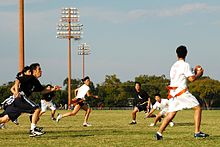- Flag football
-
Flag football 
An Intramural recreational league game of co-ed flag football at the University of Texas at AustinFirst played United States Characteristics Team members 2 teams of 4–11 Flag football is a version of Canadian football or American football that is popular worldwide. The basic rules of the game are similar to those of the mainstream game (often called "tackle football" for contrast), but instead of tackling players to the ground, the defensive team must remove a flag or flag belt from the ball carrier ("deflagging") to end a down. In most organized play, players wear a belt. These belts vary from "Triple Threat" which the entire flag belt is removed, to "Sonic Pop" which only the flag is pulled.
Contents
Variations
Chiefly because there is no dominant sanctioning organization for the sport, the game has mutated into many variations: 9-man, 8-man, 7-man, 5-man, and 4-man on a side; with kicking and punting and without; with point-after conversions (including some with 1, 2, and 3 point tries) or without; and field sizes that vary from full CFL size, NFL size (120 yards long by 53 1/3 yards wide), to fields a third that size.
An important distinction is whether linemen are allowed to catch passes ("Eligible Linemen") or, as in the CFL / NFL, are not allowed to do so ("Ineligible Linemen"). Flag (and touch) football may also be divided into "contact" or "non-contact", depending on whether or not blocking is allowed; if allowed, blocking is usually restricted to the chest.
In Non-Contact flag football, there is no blocking, usually no linemen, and if there are linemen they can not use their hands to block an opponent. Defensive players cannot get in the way of a runner; they can only attempt to grab the flag without impeding the path of the runner. Offensive players are not allowed to hand block defensive players to prevent them from grabbing the flag.
In Contact flag football, none of the rules above apply. There are linemen blocking only around chest area, no chop blocks or blocks below the waist. Defensive players can get in the path of an offensive player to attempt to grab the flag.
Competition
The sport has a strong amateur following and several national and international competitions each year sponsored by various associations.
International
The International Flag Football Festival (IFFF) organizes the World Cup of Flag Football featuring teams from the United States, Mexico and several other nations.
The International Federation of American Football (IFAF) organizes the IFAF Flag Football World Championship every two years since 2002.
The International Woman's Flag Football Association hosts contact flag football tournaments across the world with participants from the United States, Canada, Mexico, Sweden, Norway, Finland, Denmark and several other nations. The organization also known as the IWFFA is the largest organization for women and girls in the sport of flag football. The most active tournament is held each February in Key West, Florida, called the Kelly McGillis Classic where over 90 women and girls teams participate in 20on98 contact flag football.
North America
The United States Flag and Touch Football League (USFTL) has a number of smaller organizations spread out over the US. Located in Ohio, this league supports a number of teams from the Mid Atlantic, NorthEast, and Midwest states.
The NFL conducts their own Youth World Championship for children 12–14 years of age. Held in different nations around the world. It is five man no contact football played between ten countries. Previous NFL Flag Football World Championships have been held in Beijing, Cologne, Mexico City, Tokyo, Toronto, and Vancouver. The NFL has also at times sanctioned "Air It Out" competitions aimed primarily at its fans in which tournament-winning teams were allowed to compete against retired NFL All-Pros. Many universities around the continent have flag football divisions and leagues.
Europe
Flag football competition in the United Kingdom is organized by the BAFA Community Leagues. At a senior level as of 2011, it is played by fifteen teams divided into two regional conferences, North (Scotland), and South (England & Wales) with the top teams qualifying for playoffs at the end of the season. The league also organizes teams competing at youth and cadet levels.[1][2] Flag matches in the UK are played with five players on each side with no contact, and are officiated according to the IFAF flag football rules with a few minor variations.[3]
Asia
In Korea, the biggest tournament is the National Flag Football Tournament held by the Korean Flag Football Federation (KFFF). It attracts up to 20 teams, from middle school students to adults.
See also
References
- ^ "BAFACL Flag South". BAFA Community Leagues. http://www.bafacl.com/ProcessPublicSelect.do?psSelectedSeason=2508756&psSelectedDivision=6055368&go=Go&psSelectedLeague=1015756. Retrieved 5 May 2011.
- ^ "BAFACL Flag North". BAFA Community Leagues. http://www.bafacl.com/ProcessPublicSelect.do?psSelectedSeason=2508756&psSelectedDivision=6745875&psSelectedLeague=1015756. Retrieved 5 May 2011.
- ^ "BAFA Rules Committee - Flag football". British American Football Referees' Association. http://www.bafra.org/rulesctee/flag/index.htm. Retrieved 17 September 2010.
External links
- IFAF 2011 flag football rulebook
- International Woman's Flag Football Association
- American Flag and Touch Football League
- United States Flag Football Association
- United States Flag and Touch Football League
- FlagFootballX
Categories:- Flag football
- Variations of American football
Wikimedia Foundation. 2010.
